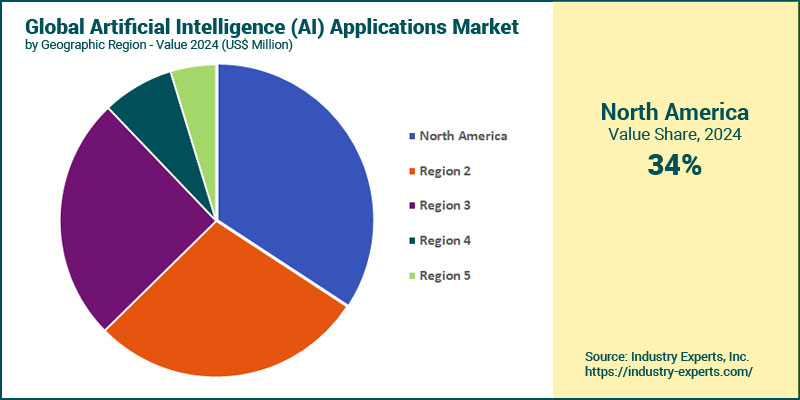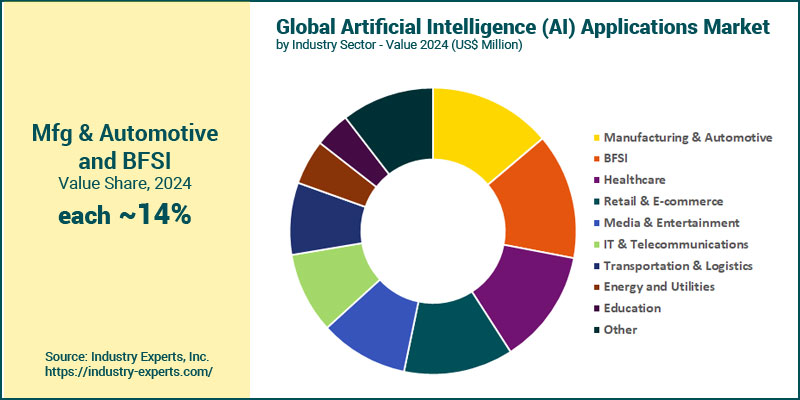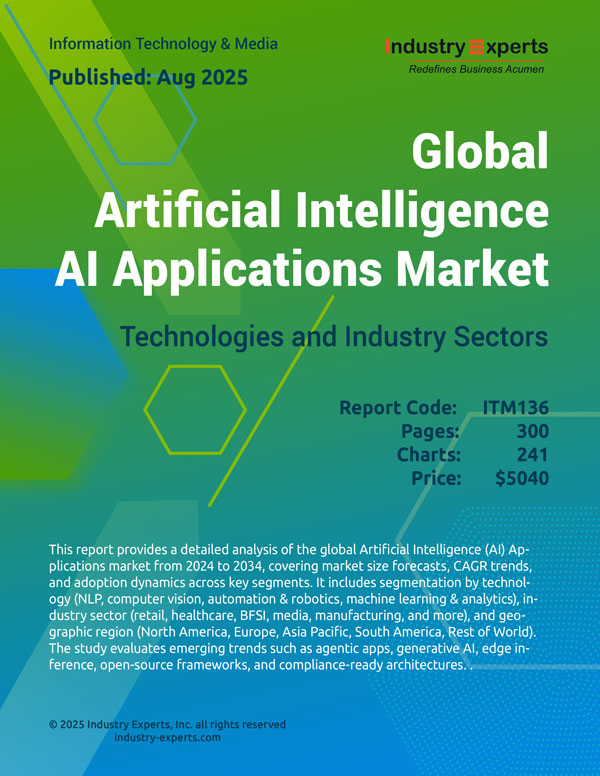Global Artificial Intelligence (AI) Applications Market - Technologies and Industry Sectors
- Published: Aug 2025
- Pages: 300 | Charts: 241
- Report Code: ITM136
Global Artificial Intelligence (AI) Applications Market Trends and Outlook
The global Artificial Intelligence (AI) Applications market is on a steep growth trajectory, expected to surge from US$3.3 billion in 2024 to nearly US$75 billion by 2034, registering a remarkable CAGR of 36.9%. AI apps, defined as enterprise or consumer software products with embedded artificial intelligence capabilities, are becoming foundational to modern IT ecosystems. These applications are no longer add-ons but integral to decision support, workflow automation, and user personalization across key functions such as finance, HR, operations, and customer experience.

This growth is underpinned by the widespread availability of large language models (LLMs), maturing cloud-native platforms, and increased enterprise readiness to adopt modular, composable AI architectures. Enterprises are embracing both vertical-specific and cross-functional AI solutions, from smart procurement bots and recommendation engines to fraud detection tools and generative content platforms. The rise of agentic AI apps, capable of autonomous, multi-step task execution, is further accelerating adoption across knowledge-intensive sectors.
Artificial Intelligence (AI) Applications Regional Market Analysis
North America remains the largest regional market, contributing an estimated US$1.1 billion in 2024, or around 34% of global revenue, driven by advanced cloud infrastructure, mature enterprise IT ecosystems, and early adoption of LLM-based solutions across industries. By 2034 the region is projected to grow at a CAGR of 28.2%. Asia Pacific is the fastest-growing region, expanding to US$37.7 billion by 2034, at an exceptional CAGR of 46.6%. This growth is fueled by digital transformation initiatives in China, India, Southeast Asia, and Japan, as well as increasing AI investments by both governments and enterprises. Strong momentum in sectors like e-commerce, financial services, and healthcare is accelerating demand for AI-driven applications across the region.

Artificial Intelligence (AI) Applications Market Analysis by Technology
Technologically, the market is diversifying rapidly across several AI capabilities. Computer Vision is expected to become the largest and fastest-growing technology segment, registering a CAGR of 41.2% over 2024-2034. Its adoption is being driven by use cases in automated inspection, facial recognition, augmented reality, and autonomous systems across logistics, manufacturing, and media. Natural Language Processing (NLP) follows closely, growing at a CAGR of 33.1%. NLP underpins a wide range of AI apps, from virtual assistants and generative AI to chatbots and document intelligence, especially within customer service, HR, and compliance domains. Automation & Robotics and Machine Learning & Predictive Analytics are also gaining traction, with strong use in enterprise operations, forecasting, and smart workflows. While Other AI technologies remain smaller in share, they continue to support niche and experimental use cases.
Artificial Intelligence (AI) Applications Market Analysis by Industry Sector
Across industry sectors, the demand for AI apps is strongest in high-growth verticals. Retail & E-commerce is set to be the largest end-use segment by 2034, reaching over US$13.9 billion, growing at a CAGR of 42.5%. This is driven by the widespread deployment of AI for dynamic pricing, personalized recommendations, supply chain optimization, and omnichannel customer engagement. Media & Entertainment follows closely, projected at US$13.2 billion by 2034 with a 44.9% CAGR, benefiting from demand for generative content creation, audience analytics, and virtual production. In terms of growth rate, Media & Entertainment is the fastest-growing industry, followed by Retail & E-commerce, Healthcare, and BFSI. These industries are aggressively adopting AI apps to enhance personalization, automate operations, and meet evolving consumer and compliance demands. Even traditionally slower sectors like Education and Energy & Utilities are seeing significant momentum, particularly through intelligent learning platforms and grid optimization solutions.

Artificial Intelligence (AI) Applications Market Report Scope
This global report on Artificial Intelligence (AI) Applications market analyzes the global and regional market based on Technology, and Industry Sector for the period 2024-2034 in terms of value in US$. In addition to providing profiles of major companies operating in this space, the latest corporate and industrial developments have been covered to offer a clear panorama of how and where the market is progressing.
Key Metrics
| Base Year: | 2024 | |
| Forecast Period: | 2024-2034 | |
| Units: | Value market in US$ | |
| Companies Mentioned: | 15+ |
Artificial Intelligence (AI) Applications Market by Geographic Region
- North America (The United States, Canada and Mexico)
- Europe (Germany, the United Kingdom, France, Italy, the Netherlands, Spain, Russia, Switzerland and Rest of Europe)
- Asia-Pacific (China, Japan, India, Australia, Singapore, South Korea and Rest of Asia-Pacific)
- South America (Brazil, Argentina, Colombia, Chile, Peru and Rest of South America)
- Middle East & Africa (the United Arab Emirates, South Africa, Egypt, Saudi Arabia, Morocco, Kuwait, Qatar and Rest of Middle East & Africa)
Artificial Intelligence (AI) Applications Market by Technology
- Natural Language Processing (NLP)
- Computer Vision (CV)
- Automation & Robotics
- Machine Learning & Predictive Analytics
- Other Technologies
Artificial Intelligence (AI) Applications Market by Industry Sector
- Manufacturing & Automotive
- Banking, Financial Services, and Insurance (BFSI)
- Healthcare
- Retail & E-commerce
- Media & Entertainment
- IT & Telecommunications
- Transportation & Logistics
- Energy and Utilities
- Education
- Other Industry Verticals
Artificial Intelligence (AI) Applications Market Frequently Asked Questions (FAQs)
The AI Applications market includes software applications that embed artificial intelligence to perform tasks like automation, prediction, personalization, and natural language processing. These apps are used across industries including healthcare, retail, manufacturing, BFSI, and education, enabling smarter workflows and enhanced user experiences.
In 2024, the global AI Apps market is valued at approximately US$3.3 billion. It is forecast to grow to US$75 billion by 2034, achieving a compound annual growth rate (CAGR) of 36.9% over the 2024-2034 period. This growth is driven by enterprise digital transformation and increasing integration of AI into mission-critical software.
Key drivers include the democratization of LLMs, advances in cloud infrastructure, API-first AI deployment models, and the enterprise shift from siloed pilots to AI-as-a-platform. AI apps improve efficiency, reduce manual workload, and enable real-time insights, making them critical in sectors like finance, logistics, healthcare, and e-commerce.
Industries such as Retail & E-commerce, Media & Entertainment, and Healthcare are among the fastest-growing adopters due to strong use cases in personalization, generative content, diagnostics, and automated service. BFSI, Manufacturing, and Education sectors are also expanding their AI app deployments.
Top technologies include Computer Vision, Natural Language Processing (NLP), Machine Learning & Predictive Analytics, Automation & Robotics, and Generative AI. Among these, Computer Vision is growing the fastest due to its use in smart surveillance, quality control, and augmented reality applications.
Leading enterprise vendors include SAP, Salesforce, Oracle, Microsoft, and IBM, all of whom embed AI into their platforms. Pure-play and open-source innovators such as C3.ai, DataRobot, AssemblyAI, H2O.ai, and LangChain offer composable AI solutions tailored for industry use cases.
Challenges include AI model transparency, talent shortages, scaling beyond pilot projects, and evolving global regulations such as the EU AI Act and India's DPDP Bill. Vendor lock-in and lack of interoperability are also concerns, pushing demand for open-source and standards-compliant frameworks.
PART A: GLOBAL MARKET PERSPECTIVE
1. EXECUTIVE SUMMARY
- A Roundup on Artificial Intelligence (AI) Applications
- Market Segmentation for Artificial Intelligence (AI) Applications
- Technology
- Industry Sectors
- Key Trends in Artificial Intelligence (AI) Applications Market
2. INDUSTRY LANDSCAPE
- Global Artificial Intelligence (AI) Applications Market Outlook
- Comprehensive Artificial Intelligence (AI) Applications Industry Analysis - Growth Drivers and Inhibitors
- Growth Drivers
- Growth Inhibitors
- Market Entry Strategies for Artificial Intelligence (AI) Applications Industry
- Startup Strategies for Artificial Intelligence (AI) Applications Industry
- SWOT Analysis of Artificial Intelligence (AI) Applications Industry
- Strengths
- Weaknesses
- Opportunities
- Threats
- Porter's Five Forces Analysis
- PESTEL Analysis
3. COMPETITIVE LANDSCAPE
- Market Positioning of Key Artificial Intelligence (AI) Applications Companies
- Market Share Analysis of Artificial Intelligence (AI) Applications Companies
- SWOT Analysis of Key Players in the Artificial Intelligence (AI) Applications Industry
- Key Market Players
- Amazon
- AssemblyAI, Inc.
- C3.ai
- DataRobot, Inc
- ELSA
- FaceApp
- Google LLC
- H2O.ai
- IBM Corporation
- LangChain
- Microsoft Corporation
- Salesforce
- SAP
- OpenAI
- Oracle
4. KEY BUSINESS & PRODUCT TRENDS
5. GLOBAL MARKET OVERVIEW
- Global Artificial Intelligence (AI) Applications Market Overview by Technology
- Artificial Intelligence (AI) Applications Technology Market Overview by Global Region
- Natural Language Processing (NLP)
- Computer Vision (CV)
- Automation & Robotics
- Machine Learning & Predictive Analytics
- Other Technologies
- Global Artificial Intelligence (AI) Applications Market Overview by Industry Sector
- Artificial Intelligence (AI) Applications Industry Sector Market Overview by Global Region
- Manufacturing & Automotive
- Banking, Financial Services, and Insurance (BFSI)
- Healthcare
- Retail & E-commerce
- Media & Entertainment
- IT & Telecommunications
- Transportation & Logistics
- Energy and Utilities
- Education
- Other Industry Verticals
PART B: REGIONAL MARKET PERSPECTIVE
- Global Artificial Intelligence (AI) Applications Market Overview by Geographic Region
REGIONAL MARKET OVERVIEW
6. NORTH AMERICA
- North American Artificial Intelligence (AI) Applications Market Overview by Geographic Region
- North American Artificial Intelligence (AI) Applications Market Overview by Technology
- North American Artificial Intelligence (AI) Applications Market Overview by Industry Sector
- Country-wise Analysis of North American Artificial Intelligence (AI) Applications Market
- THE UNITED STATES
- United States Artificial Intelligence (AI) Applications Market Overview by Technology
- United States Artificial Intelligence (AI) Applications Market Overview by Industry Sector
- CANADA
- Canadian Artificial Intelligence (AI) Applications Market Overview by Technology
- Canadian Artificial Intelligence (AI) Applications Market Overview by Industry Sector
- MEXICO
- Mexican Artificial Intelligence (AI) Applications Market Overview by Technology
- Mexican Artificial Intelligence (AI) Applications Market Overview by Industry Sector
7. EUROPE
- European Artificial Intelligence (AI) Applications Market Overview by Geographic Region
- European Artificial Intelligence (AI) Applications Market Overview by Technology
- European Artificial Intelligence (AI) Applications Market Overview by Industry Sector
- Country-wise Analysis of European Artificial Intelligence (AI) Applications Market
- GERMANY
- German Artificial Intelligence (AI) Applications Market Overview by Technology
- German Artificial Intelligence (AI) Applications Market Overview by Industry Sector
- THE UNITED KINGDOM
- United Kingdom Artificial Intelligence (AI) Applications Market Overview by Technology
- United Kingdom Artificial Intelligence (AI) Applications Market Overview by Industry Sector
- FRANCE
- French Artificial Intelligence (AI) Applications Market Overview by Technology
- French Artificial Intelligence (AI) Applications Market Overview by Industry Sector
- ITALY
- Italian Artificial Intelligence (AI) Applications Market Overview by Technology
- Italian Artificial Intelligence (AI) Applications Market Overview by Industry Sector
- THE NETHERLANDS
- Dutch Artificial Intelligence (AI) Applications Market Overview by Technology
- Dutch Artificial Intelligence (AI) Applications Market Overview by Industry Sector
- SPAIN
- Spanish Artificial Intelligence (AI) Applications Market Overview by Technology
- Spanish Artificial Intelligence (AI) Applications Market Overview by Industry Sector
- RUSSIA
- Russian Artificial Intelligence (AI) Applications Market Overview by Technology
- Russian Artificial Intelligence (AI) Applications Market Overview by Industry Sector
- SWITZERLAND
- Swiss Artificial Intelligence (AI) Applications Market Overview by Technology
- Swiss Artificial Intelligence (AI) Applications Market Overview by Industry Sector
- REST OF EUROPE
- Rest of Europe Artificial Intelligence (AI) Applications Market Overview by Technology
- Rest of Europe Artificial Intelligence (AI) Applications Market Overview by Industry Sector
8. ASIA-PACIFIC
- Asia-Pacific Artificial Intelligence (AI) Applications Market Overview by Geographic Region
- Asia-Pacific Artificial Intelligence (AI) Applications Market Overview by Technology
- Asia-Pacific Artificial Intelligence (AI) Applications Market Overview by Industry Sector
- Country-wise Analysis of Asia-Pacific Artificial Intelligence (AI) Applications Market
- CHINA
- Chinese Artificial Intelligence (AI) Applications Market Overview by Technology
- Chinese Artificial Intelligence (AI) Applications Market Overview by Industry Sector
- JAPAN
- Japanese Artificial Intelligence (AI) Applications Market Overview by Technology
- Japanese Artificial Intelligence (AI) Applications Market Overview by Industry Sector
- INDIA
- Indian Artificial Intelligence (AI) Applications Market Overview by Technology
- Indian Artificial Intelligence (AI) Applications Market Overview by Industry Sector
- AUSTRALIA
- Australia Artificial Intelligence (AI) Applications Market Overview by Technology
- Australia Artificial Intelligence (AI) Applications Market Overview by Industry Sector
- SINGAPORE
- Singaporean Artificial Intelligence (AI) Applications Market Overview by Technology
- Singaporean Artificial Intelligence (AI) Applications Market Overview by Industry Sector
- SOUTH KOREA
- South Korean Artificial Intelligence (AI) Applications Market Overview by Technology
- South Korean Artificial Intelligence (AI) Applications Market Overview by Industry Sector
- REST OF ASIA-PACIFIC
- Rest of Asia-Pacific Artificial Intelligence (AI) Applications Market Overview by Technology
- Rest of Asia-Pacific Artificial Intelligence (AI) Applications Market Overview by Industry Sector
9. SOUTH AMERICA
- South American Artificial Intelligence (AI) Applications Market Overview by Geographic Region
- South American Artificial Intelligence (AI) Applications Market Overview by Technology
- South American Artificial Intelligence (AI) Applications Market Overview by Industry Sector
- Country-wise Analysis of South American Artificial Intelligence (AI) Applications Market
- BRAZIL
- Brazilian Artificial Intelligence (AI) Applications Market Overview by Technology
- Brazilian Artificial Intelligence (AI) Applications Market Overview by Industry Sector
- ARGENTINA
- Argentine Artificial Intelligence (AI) Applications Market Overview by Technology
- Argentine Artificial Intelligence (AI) Applications Market Overview by Industry Sector
- COLOMBIA
- Colombian Artificial Intelligence (AI) Applications Market Overview by Technology
- Colombian Artificial Intelligence (AI) Applications Market Overview by Industry Sector
- CHILE
- Chilean Artificial Intelligence (AI) Applications Market Overview by Technology
- Chilean Artificial Intelligence (AI) Applications Market Overview by Industry Sector
- PERU
- Peruvian Artificial Intelligence (AI) Applications Market Overview by Technology
- Peruvian Artificial Intelligence (AI) Applications Market Overview by Industry Sector
- REST OF SOUTH AMERICA
- Rest of South America Artificial Intelligence (AI) Applications Market Overview by Technology
- Rest of South America Artificial Intelligence (AI) Applications Market Overview by Industry Sector
10. MIDDLE EAST & AFRICA
- Middle East & Africa Artificial Intelligence (AI) Applications Market Overview by Geographic Region
- Middle East & Africa Artificial Intelligence (AI) Applications Market Overview by Technology
- Middle East & Africa Artificial Intelligence (AI) Applications Market Overview by Industry Sector
- Country-wise Analysis of Middle East & Africa Artificial Intelligence (AI) Applications Market
- THE UNITED ARAB EMIRATES
- United Arab Emirates Artificial Intelligence (AI) Applications Market Overview by Technology
- United Arab Emirates Artificial Intelligence (AI) Applications Market Overview by Industry Sector
- SOUTH AFRICA
- South African Artificial Intelligence (AI) Applications Market Overview by Technology
- South African Artificial Intelligence (AI) Applications Market Overview by Industry Sector
- EGYPT
- Egyptian Artificial Intelligence (AI) Applications Market Overview by Technology
- Egyptian Artificial Intelligence (AI) Applications Market Overview by Industry Sector
- SAUDI ARABIA
- Saudi Arabian Artificial Intelligence (AI) Applications Market Overview by Technology
- Saudi Arabian Artificial Intelligence (AI) Applications Market Overview by Industry Sector
- MOROCCO
- Moroccan Artificial Intelligence (AI) Applications Market Overview by Technology
- Moroccan Artificial Intelligence (AI) Applications Market Overview by Industry Sector
- KUWAIT
- Kuwaiti Artificial Intelligence (AI) Applications Market Overview by Technology
- Kuwaiti Artificial Intelligence (AI) Applications Market Overview by Industry Sector
- QATAR
- Qatari Artificial Intelligence (AI) Applications Market Overview by Technology
- Qatari Artificial Intelligence (AI) Applications Market Overview by Industry Sector
- REST OF MIDDLE EAST & AFRICA
- Rest of Middle East & Africa Artificial Intelligence (AI) Applications Market Overview by Technology
- Rest of Middle East & Africa Artificial Intelligence (AI) Applications Market Overview by Industry Sector
PART C: ANNEXURE
- RESEARCH METHODOLOGY
- FEEDBACK
Amazon
AssemblyAI, Inc.
C3.ai
DataRobot, Inc
ELSA
FaceApp
Google LLC
H2O.ai
IBM Corporation
LangChain
Microsoft Corporation
Salesforce
SAP
OpenAI
Oracle
Related Reports
| Report | Published | Price |
|---|---|---|
| Content Delivery Network (CDN) - A Global Market Overview | Sep 24, 2025 | $5490 |
| Global AI Consulting and Support Services Market - Service Types, Company Types and Industry Sectors | Sep 23, 2025 | $5490 |
| Application Life-Cycle Management (ALM) Software - A Global Market Overview | Sep 23, 2025 | $5490 |
| Managed Storage Services - A Global Market Overview | Aug 21, 2025 | $5490 |

